By Cassandra Taylor, Publications Assistant
“I love pilgrimages. I really do,” remarked Kateri Davis ’25.
Those simple words would have sounded a little strange to the pilgrim balancing his mud-soaked shoes on an albergue radiator only a few short weeks ago. The distance between Sarria—a small town in Galicia—and the city of Santiago de Compostela, home to the tomb of the apostle St. James the Great, is 115 kilometers. Just over 70 miles, it can be driven in 1.5 hours. For us, however—the Thomas More College pilgrims who had chosen to spend Easter break visiting Madrid, León, and traversing the last leg of the Camino Francés—115 kilometers meant five days of walking: five days of rain, hail, thunder, mud, pain, tears, prayer, and ultimately, glory.
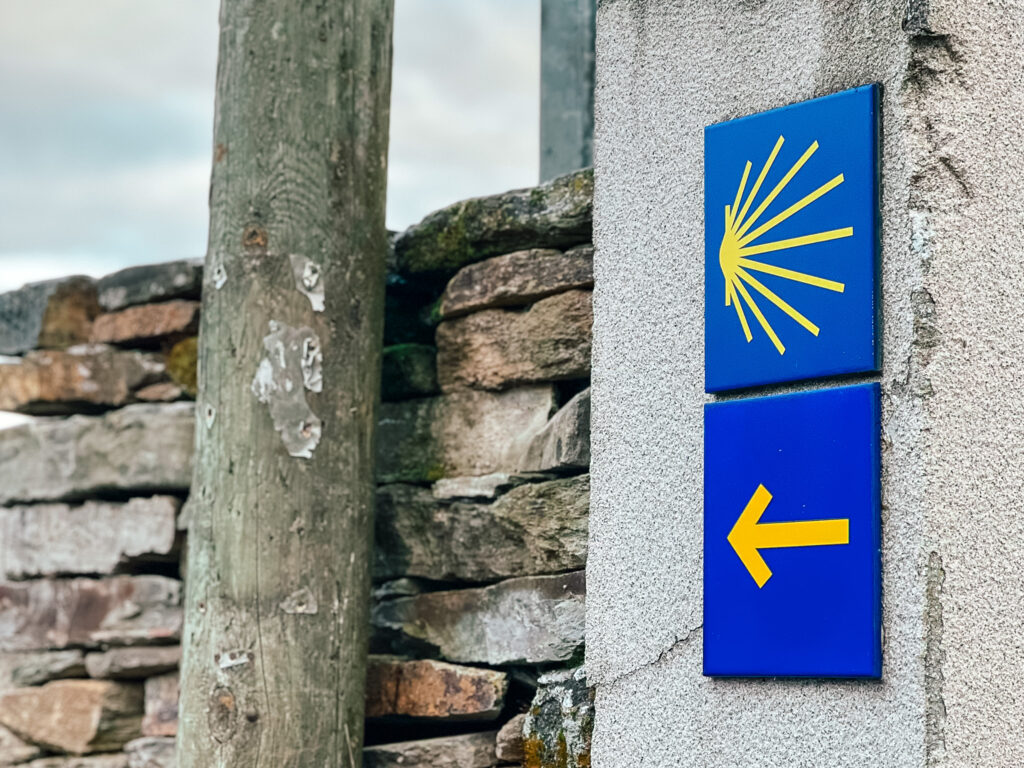
Since the Middle Ages, pilgrims have been walking the Way of St. James. There are many routes, but the most popular and well-established is the Camino Francés, or “French Way,” stretching from Saint-Jean-Pied-de-Port in the French Pyrenees across Spain to the western province of Galicia. My husband, Teaching Fellow and Dean of Students Dr. Michael Taylor, had been wanting to walk the Camino for some time, but had never found the right moment—even during the years we were living in Spain before coming to Thomas More. But at the beginning of the academic year, he received encouragement from a few of the College’s board members, and he began to plan. Beginning with the students in his Plus Ultra upper tutorial “on Spanish faith, conquest, and evangelization,” a group began to form. Eventually the final company was established: twenty-one faculty, staff, students, alumni, and friends of the College willing to make the necessary sacrifices and go five days on foot in honor of St. James.
“A pilgrimage is a journey which symbolizes our response to the call of the Father that we should return to Him,” wrote Fellow and President Dr. William Fahey, who was among the pilgrims, in the Pequeño Camino—“Little Way”—that he composed to provide spiritual guidance to the group. “It is a privilege to be called to visit places associated with His Son and the friends of His Son. We journey with only an inkling of the road ahead. We journey in faith that does not limit how the Father will guide our path. We journey without insisting that we determine the gifts along the way. The Camino is a gift.” With each considering his rationale for going on pilgrimage in his heart, and with a blessing from Fr. Rory Traynor, the pilgrims departed for Spain on Friday, April 11, 2025.

Upon landing in Madrid, we shouldered our packs and headed to dinner in one of the capital’s oldest restaurants. Tucked into the brick-vaulted wine cellar, we met with author and thinker Vicente Miró, bioethicist and professor Dr. Elena Postigo Solana, award-winning documentarian José Luis López-Linares, and Miguel Bertodano, a descendant of the English martyr St. Philip Howard. These friends of the College, both old and new, provided the group with fascinating conversation and perspective as we began our journey.
From Madrid, the pilgrims traveled to León. In this ancient city, founded by the VI Roman legion under Augustus, we visited the Gothic cathedral and the Basilica of St. Isidore, which houses the Sevillian saint’s relics. First however, we hurried to the Real Colegiata museum for our one chance to lay eyes on the reason we had chosen to begin our pilgrimage in León: the chalice of Doña Urraca, which a group of Spanish researchers believe could be the Holy Grail. It is a simple Roman onyx cup that was covered with the princess’s gold and jewels, with the bowl’s lid used as the base of the chalice. After venerating this striking artifact, we attended Palm Sunday Mass in the cathedral’s high-ceilinged side-chapel, which is dedicated to the Blessed Sacrament. Later, the pilgrims witnessed several Holy Week processions cross the square in front of the cathedral, with penitents in traditional garb bearing images relating to Our Lord’s Passion. We bought our pilgrims’ shells and tied them to our packs, considering the way that lay ahead.
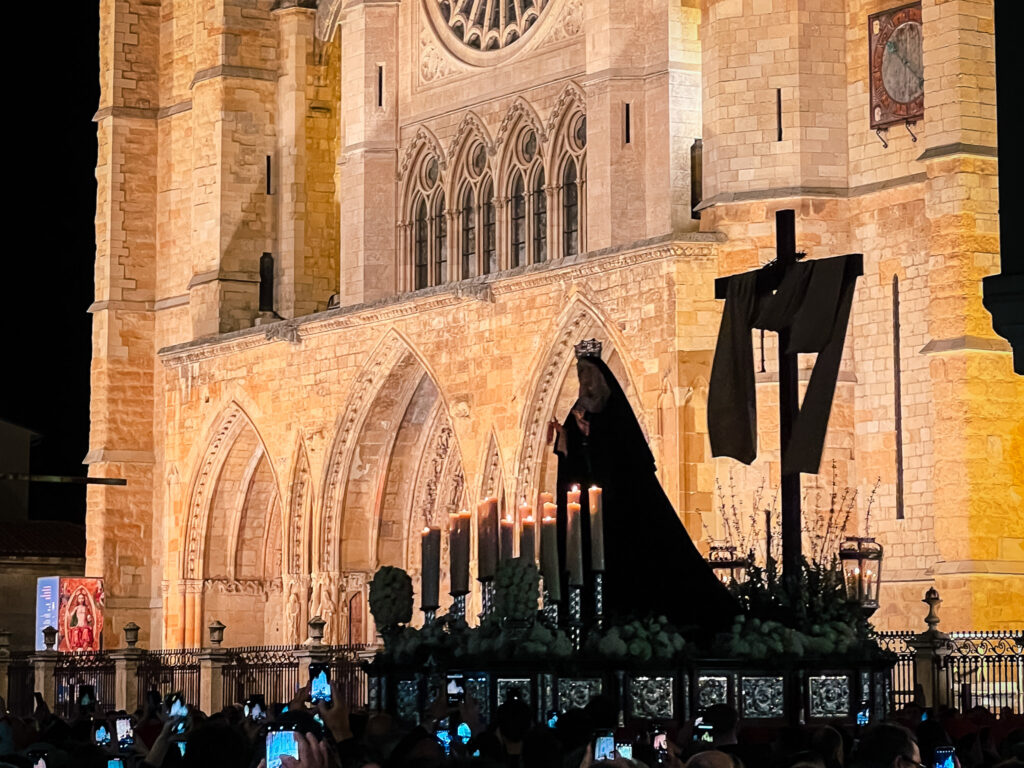
From León we bussed to Sarria, and the next morning—after finding occasion to sing “Red is the Rose” to the owner of an Italian pizzeria, in true TMC style—we donned our backpacks and faced our fears. On the morning of Tuesday in Holy Week, with some short prayers from our little red prayer book recited outside of the parochial church of Santa Mariña, the group stepped off for a long walk through the Spanish countryside in search of St. James. The foibles, mishaps, and personal struggles—which began before we even left our first albergue (pilgrims’ hostel)—were ever-present. But in spite—or perhaps because—of everything, the pilgrimage was deeply moving for all—even life-changing.
“Coming together with my fellow travelers and pilgrims, I see how, on our trek, we experienced the journey as a ‘way’ to interior renewal, to a deepening of faith, and to a strengthening of our sense of communion and solidarity,” reflected Jacinta Sigaud ’26. “As Pope St. John Paul II put it, my fellow pilgrims and I were able ‘to recapture the spirit of the pilgrims of old.’ That is a true blessing. We walked the Way of St. James imperfectly but sincerely, strengthened by the love of God and the fellowship of the Holy Spirit shared with each other, with the pilgrims who came before us and with the pilgrims who will come after.”
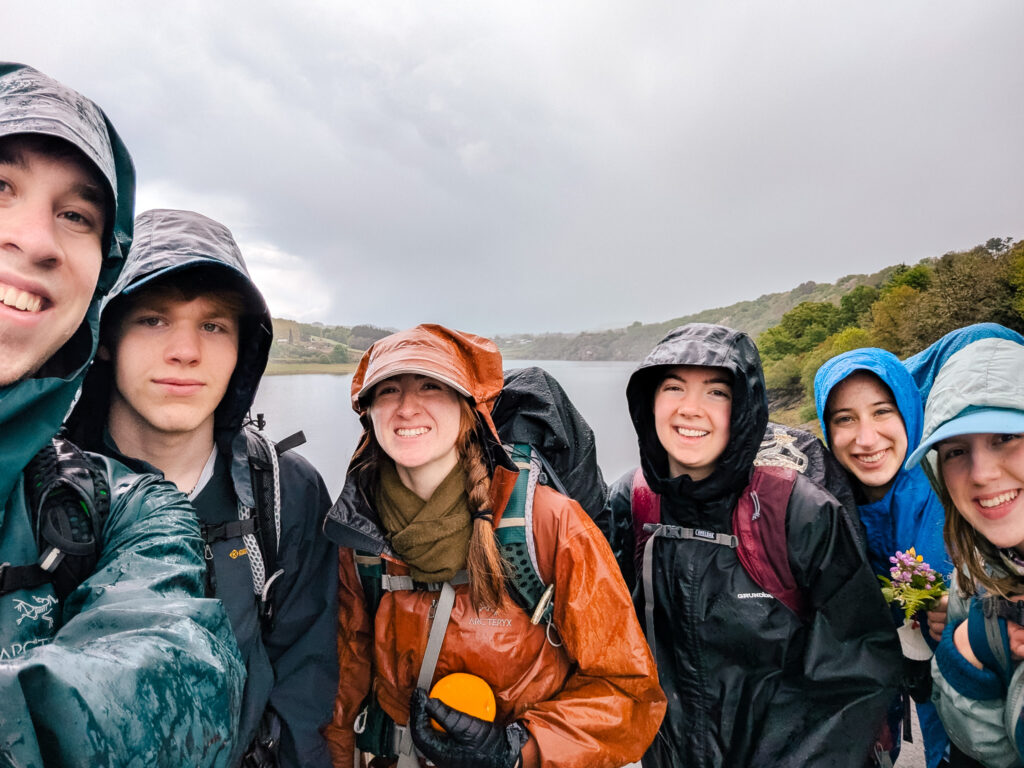
“One of the most valuable things I found on my journey is that we are to always live in the moment. Appreciate it. Love it,” encouraged David Arias ’26. “The moment is what is happening at present, and that is our life. Not worrying about our past, or our future, but our here and now.” He continued by offering advice to any future pilgrim: “Live in the moment. Welcome each day—its pleasures and its challenges. Make others feel welcome. Share. Feel the spirit of those who have come before you. Imagine those who will follow you. Appreciate those who walk with you today.”
“Shortly after returning from pilgrimage in Spain, I attended a lecture on the importance of friendship in the development of virtue,” reflected Peter Rao ’24. “The Australian priest delivering the address used the example of the Camino de Santiago specifically to illustrate his point, explaining that, ‘On the Camino, you never walk alone. You can never get away from people, as you’re constantly accompanied by other pilgrims walking on the same trail to the same destination.’ In some cases, he joked, it can temporarily turn extroverts into introverts, and vice-versa. His point, however, was to show that, in the same way that companionship is a necessity for struggling through the Way, it is also a necessity in struggling through the pilgrimage of life. This obvious symbolism transforms a hike into a source of hope for everyday life. Something as simple as carrying someone’s backpack or accepting help is packed with significance. Such a memory can serve as a call to action once you return home. Walking the Camino has long been on my bucket list, but I always pictured myself doing it alone. I’m incredibly grateful that I went with friends, acquaintances, and strangers. Being in a group demands more of you; but you reap much more because of it.”
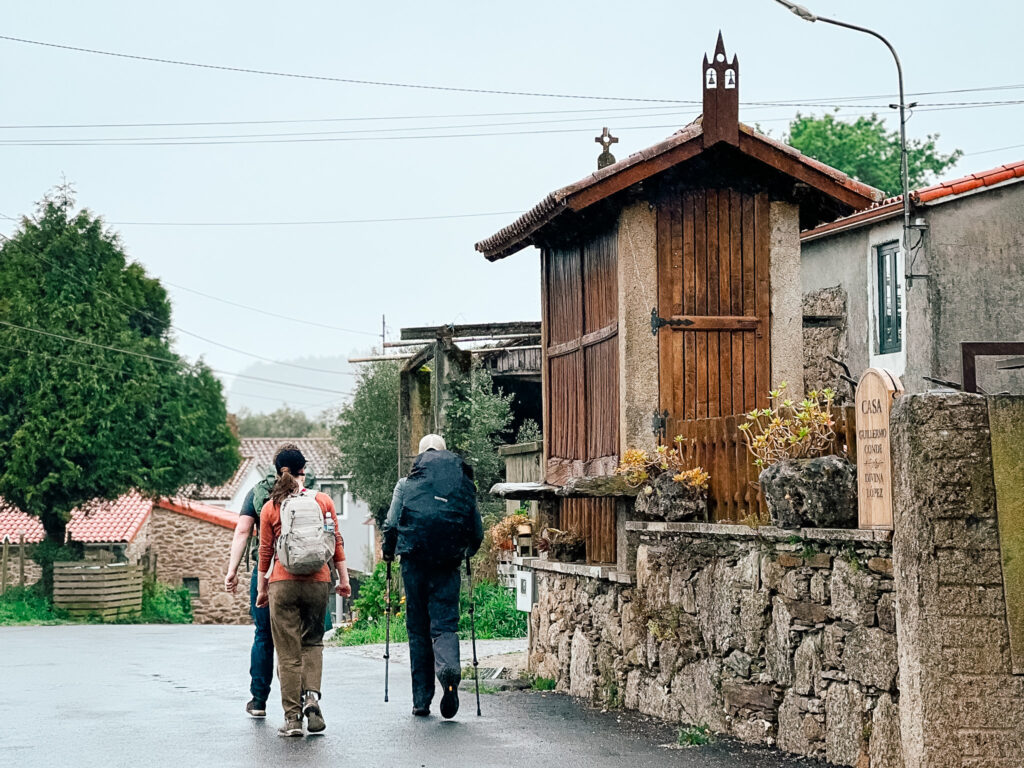
We reached our destination on Holy Saturday. The weather had been difficult all week—when it hailed the first day, we felt like we were real pilgrims—, but that day and the day before, as we observed our Lord’s Passion, death, and entombment, there had been a steady, soaking rain. But finally beholding the magnificent Baroque façade of the Cathedral of Santiago de Compostela was a moment of tears, prayer, and gratitude for each of us. So many people had supported this trip, with prayers and encouragement as well as financially; so many had entrusted us with the intentions that we carried, lists tucked into our backpacks and saved on our phones, lists safeguarded in the corners of our hearts and minds.
“Walking the final miles into Santiago de Compostela brought me great joy and great sadness—the joy of completing the walk, and the sadness of knowing that I was finished,” remembered Mr. Arias. “It has been a dream of mine since I was little to walk the Way of St. James, and I wouldn’t have been able to do so without the help and prayers of all my generous benefactors, friends and family. I prayed for everyone who helped me walk this pilgrimage and I offered up my challenges and weaknesses to God.” “I come away from the Camino with a deep sense of gratitude for the numerous ways we were blessed throughout the pilgrimage, from the generous donations which made it all possible to the kindness of fellow pilgrims along the way,” agreed Miss Sigaud.

A little worse for wear than when we had set out from Sarria five long days before, the pilgrims assembled in the cathedral for the Easter liturgies and to kneel in front of the tomb of St. James. On the morning of Easter Sunday, we were blessed to see our own Patrick Nagle ’25 serve as crucifer and hear Don Francisco José Prieto Fernández, Archbishop of Santiago de Compostela, offer a special greeting to “Thomas More College, its benefactors, and their intentions.” No one will forget the beauty of that Mass. A particular privilege was seeing the famous Botafumeiro—the giant thurible, which takes eight men to operate—giving glory to God in its own unique way. “Few moments in my life can rival the sight of the Botafumeiro swinging to the heights of the Cathedral of Santiago,” recalled Sofia Seidl ’26. “When we venerated the relic of St. James, amid clouds of incense and the booming of the pipe organ, the trials of the preceding week suddenly culminated in the understanding that this life itself is a pilgrimage to Heaven.”
Easter Monday found us flying home, with a day to recuperate before classes began once more, and we entered the final stretch of the semester. Although we returned to “normal” life—and to the happy sight that spring had arrived in New England while we were gone—the Camino hangs on, tugging at our hearts and minds in memories, in prayers, and in the feeling that the Way’s true significance for us has not yet fully come to light.
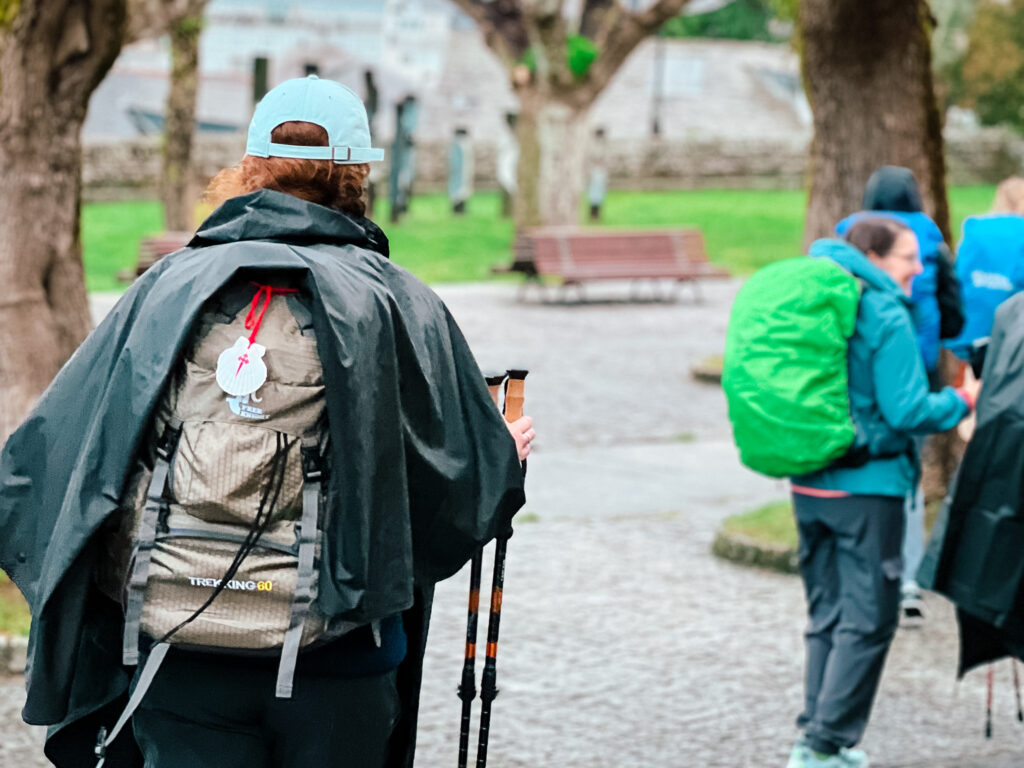
“I love pilgrimages. I really do,” said Miss Davis,
the pain, the hardships, and the joys and blessings. When reflecting on why I love them so much, I realize it’s because it is a perfect example of our lives. Whether you’re walking the Camino or walking through life, you’re going to experience hardships and pain. You’re going to have to deal with rain and hail and miles of mud; you’re going to have to climb hills even when you can hardly take another step. At times, it will seem like your destination is so far away that you’ll never make it.
But in the midst of all that, there are moments of sun, there are beautiful things to see along the way. And we, as Catholics, have the blessing to turn our sorrow to joy by offering it up to the Lord. We suffer, yes, but we suffer with love as our Lord and Savior did.
And when we reach our final destination, whether that is the Cathedral of Santiago de Compostela or the Heavenly kingdom, we stumble into the presence of our Lord, limping with pain and weighed down by the baggage we carry. We fall to the ground before the altar of God and are finally able to lay down our loads. We have made it. We have pulled through. Our hearts are overcome, and we shed tears of joy, for all of a sudden the hardships and pain don’t matter anymore, because we have arrived and are safe in the arms of Christ.
And that’s why I love pilgrimages. The journey is like our life, with all its ups and downs. The end of the pilgrimage is like a snapshot, a tiny glimpse of Heaven, and one day we will reach the end of our earthly pilgrimage and kneel before the throne of God. No more pain, no more sorrow, just joy.
The College wishes to thank all those who prayed and donated to make this pilgrimage possible.

For further reading:
TMC Students Traverse Over Sixty Miles in Pilgrimage for Restoration
